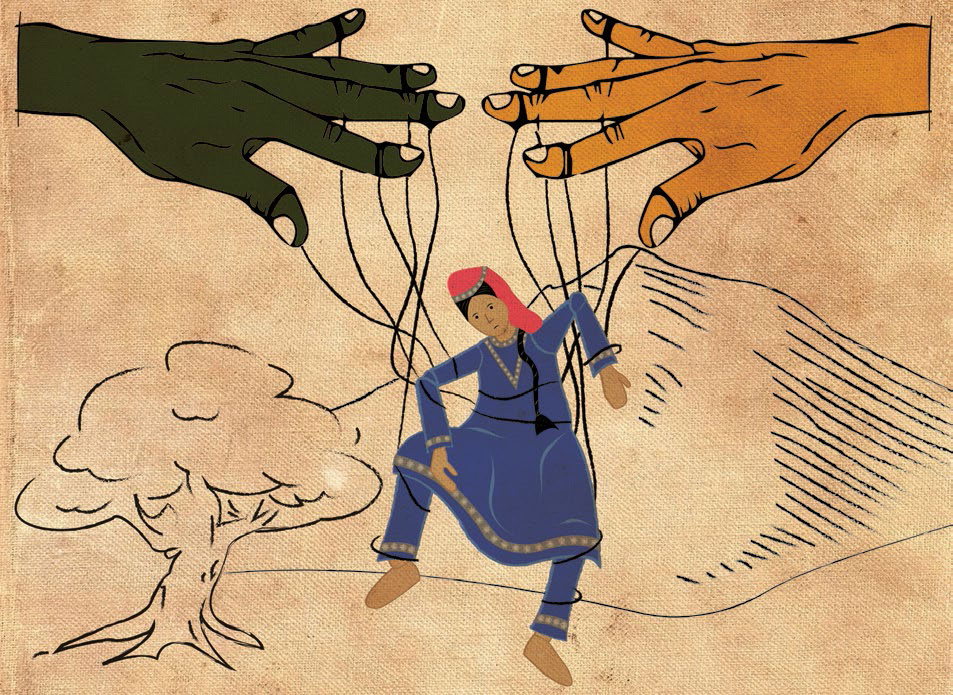Year after, year, as the voices of the Kashmiri people go unheard and stifled, even the most well meaning local leaders survive only by playing within the boundaries drawn up by their real constituents: the power-that-be… in faraway New Delhi and Islamabad… Anuradha Bhasin Jamwal takes us inside the ‘remote controlled’ valley.
It may have been a bit of an embarrassment when my daughter, while writing her Class I exam, put down ‘New Delhi’ as the answer to the question, ‘what is the capital of Jammu and Kashmir?’ But I couldn’t also help marveling at her coincidental political correctness.
At a time when parliamentary elections are over the heads and the assembly elections just around the corner, and there is plenty of speculation going on about who would win the half a dozen Lok Sabha seats from Jammu and Kashmir and who would form the next government in the state in a year’s time, those well versed with the politics of this state would reserve their judgment, appearing more clueless about its fate. Electoral politics here are not just shaped by local influences and the national level issues; they are more determined by what the Indian State ruling from New Delhi aspires for this ‘crown’ of India. With the Indian political scenario still too confusing and poised for a hung verdict, it may still be too premature to make even a rough assessment, even though a change of rulers in New Delhi is unlikely to make much of a difference to the Kashmir political scenario. History is instructive that the Kashmir policy of any political party has not been much different from any other; there’s need to also realise that former Indian prime minister Vajpayee’s promise to resolve Kashmir within the ‘insaniyat ka dayira’ was not quite in keeping with his party line but corresponded to the shifting geo-political scenario during his rule.
Even a statesman like Nehru was wary of the leaders of Jammu and Kashmir and treated them with suspicion and is on record to have maintained that ‘democracy and morality can wait till things improve in Kashmir’.
It was not without reason that the loquacious and flamboyant leader of the National Conference, Farooq Abdullah, stated some years ago that in Kashmir, it is Delhi which takes the political decisions, including the decisions on the dynamics of internal power politics. Smitten by the rout of his party in 2002, it wasn’t just an outburst of a frustrated mind. There was an element of truth in what he said. It was back in 1980s, during his first tenure as Chief Minister, when he felt duty bound to say that he was “an agent of India”. India”. Having tasted the bitter pill of his deposition in 1983, he became well aware of the significance of keeping New Delhi in good humour and that reminder may have been the bedrock of both his decisions to enter into an alliance with Rajiv Gandhi in 1987, better known as Rajiv-Farooq accord, and dump the sinking third front to join the BJP led NDA government in 1998. Farooq Abdullah was not the only one to have borne the brunt of the arbitrary whims and policies of the rulers in Delhi, even though he may be the more vocal one, especially when out of power. Everybody else knows that well enough.
That Sheikh Abdullah was dethroned in 1953 and arrested for daring to challenge New Delhi and remind Nehru of his promise of plebiscite on Kashmir was just the beginning. His replacement by Ghulam Mohammed Bakshi was made possible with the support of the very loyalists of the Sheikh, only with Delhi’s backing and insistence, even as this trusted aide of the Sheikh chose to replace the popular plebiscite slogan with ‘Kashmir is an integral part of India’. Even a statesman like Nehru was wary of the leaders of Jammu and Kashmir and treated them with suspicion and is on record to have maintained that ‘democracy and morality can wait till things improve in Kashmir’. The Sheikh rotted in and out of jails for years before he was let out only before he signed the Indira-Sheikh accord of 1975, much to the antagonism of Kashmir’s public.
It is well within the knowledge of every mainstream politician that survival in Kashmir depends on the goodwill and the strategies of New Delhi, whether it is through rigged elections, invoking of Article 356 or more subtle and invisible forms of control. The shrewdest of Kashmir’s politicians since Sheikh, Mufti Mohammad Sayeed, has been equally wary of this fundamental reality of remote controlled politics when it comes to Kashmir. Mufti, who went on to form the Peoples Democratic Party in the late 1990s, is well aware of the limitations of playing to the local galleries and even as he and his party rode on the crest of power with his promises of ‘peace process’, ‘healing touch’ and ‘human rights’ – words that were much cherished and valued in 2002– he did so with guarded and calculated caution, as he refrained from nailing New Delhi for many of the wrongs committed in Kashmir. He did what he could best do within his limited capacity as chief minister in easing the frequent frisking of civilians by security authorities , removing an odd bunker or two here and there, taking up allegations of human rights abuse with local units of the armed forces on a very low-key basis, and ensuring that untreated wounds did not spiral into anger. While in power, he didn’t raise the AFSPA revocation issue or review slogans or rake up any controversy that would endanger his own position. The very creation and survival of the PDP could not have been possible without the backing of New Delhi, which wanted to cut the National Conference down to size at that time and also felt Mufti’s presence was more desirable for initiating a peace process in Kashmir.
The rules of rigging vary according to the situation. This is one place where the muscle power of the political parties takes a back seat, especially within a militarised conflict where guns and military jackboots wield control through mechanisms like boycott calls, coerced polling and installing army-backed and intelligence-backed candidates with no grassroots following – the measures chosen thoughtfully to suit the character of each constituency.
Both of these major political parties are aware of this handicap that limits their role to performing within a certain confined radius, closely manipulated and designed by external forces, in both governance and electoral politics. Over time, only the forms have changed. In the 1951 elections, it was done by rejecting the nomination papers of anybody who could be a potential threat to Sheikh Abdullah; in 1987, it was the most brazen form of rigging with successful candidates being declared losers to suit the National Conference. The rules of rigging vary according to the situation. This is one place where the muscle power of the political parties takes a back seat, especially within a militarised conflict where guns and military jackboots wield control through mechanisms like boycott calls, coerced polling and installing army-backed and intelligence-backed candidates with no grassroots following – the measures chosen thoughtfully to suit the character of each constituency. The recent controversy involving the former army chief V.K. Singh, regarding army payoffs to the state’s ministers and politicians, further illustrates this reality.
The politics of remote control goes beyond mainstream politics. With excessive co-option of the media and intellectuals, even the separatist leadership remains subject to being magnified or dwarfed, divided or united, according to the needs of the elitist, powerful lobbies in both New Delhi and Islamabad. When it comes to Jammu and Kashmir, Islamabad is a mirror image of New Delhi, perhaps even worse; just a small indication is the fact that, in Pakistan Administered Kashmir, the two main cities of Muzaffarabad and Mirpur stand connected only through Islamabad. The cursory glance at the pathology and history of militant organisations and separatist politics in the last two decades – the long journey from JKLF to a completely divided Hurriyat – carries glimpses of craftiness, not just of New Delhi but also of Islamabad.
Geographically divided across the Line of Control, the state may have three capitals, two on this side. But politically the two remote controls certainly lie elsewhere.














